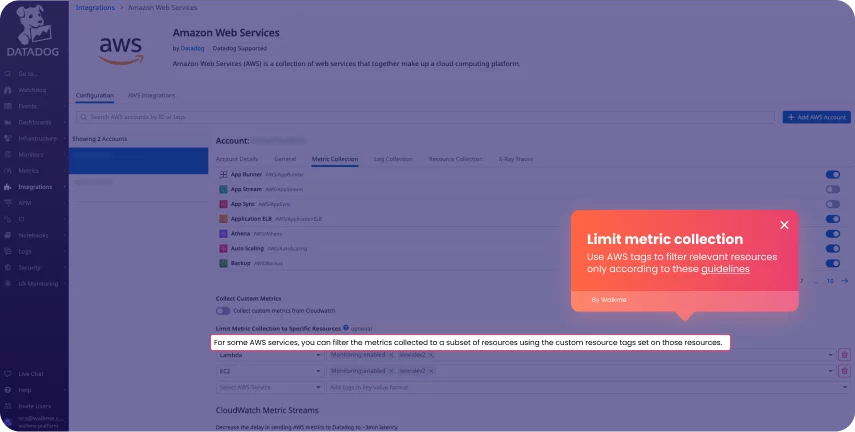With the average organization spending $48 million on digital assets every year, managing application expenses can be a mammoth task. It’s something that we learned very clearly at WalkMe when we started reviewing our Datadog usage.
Datadog is an analytics tool for monitoring servers, databases, tools, and services. It’s proven to be an instrumental tool for WalkMe’s RnD team, giving us a convenient way to observe our cloud resources and infrastructure. In addition, we use it to test products, create alerts about errors and malfunctions, and visualize and analyze WalkMe data.
Datadog has many other functions, and we soon realized that we were paying for services that we didn’t need. While we obviously knew about WalkMe’s many features, we never really thought about it as an expense optimization tool. Well, it turns out that it definitely is. Here’s how we used it to cut down on our Datadog costs without compromising on features or functionality, providing you with an easy-to-use template for you to cut down on your digital spend.
What is WalkMe’s application optimization process?
WalkMe’s platform is divided into three main sections: insights, recommendations, and actions, each of which play a role in identifying and optimizing software spend.
Insights
The insights feature provides all the data needed to understand application usage, including which features are used the most and least, which are incurring the most costs, and where expenses can be cut.
One of the first things we noticed when we started analyzing our Datadog usage with WalkMe was the sheer amount of data we could analyze. It seemed like every time we logged in, there was something new to discover.
WalkMe does this by providing real-time usage data and insights – we were able to see exactly what features we were using (and not using), where we could save money, and which users were incurring the most costs.
For example, in the screenshot below, we see how WalkMe guided us through the Datadog index filter, allowing us to sort logs according to data, time, account data, and where it’s being used within the website. After analyzing this data, we were able to get recommendations on how to optimize spend.

Recommendations
Once we had a good understanding of our Datadog usage and where we could save money, we turned to WalkMe recommendations for guidance on how to implement those changes. We were impressed with how clear and concise the recommendations were—they gave us everything we needed to know without overwhelming us with information.
Specifically, WalkMe advised us to configure Datadog to only monitor relevant resources in certain environments. We were then shown exactly how to implement these changes.
Actions
Actions provided us with the steps for implementing the recommendations, which were then turned into tutorials using WalkMe’s editor. And best of all, they were easy to implement. In just a few minutes, we had made all the changes recommended by WalkMe and immediately saw savings in our Datadog bill.
Here are a couple of examples as to how we did it:

One of the things WalkMe pointed out was that Datadog was being used to analyze our entire infrastructure. The screenshot above illustrates how we configured the software to monitor only relevant resources.

We also discovered that Datadog was running browser tests worldwide, instead of the specific locations we needed. WalkMe guided us as to how we needed to configure Datadog properly.
How else can WalkMe optimize digital resources?
In addition to helping to streamline application spend, WalkMe offers a batch of tools designed to optimize digital resources.
As the only enterprise-ready digital adoption platform (DAP), WalkMe enables you to rapidly scale your digital transformation efforts while staying agile when onboarding new software. Custom dashboards provide visibility across your entire tech-stack, while our partner ecosystem provides tips and best practices to increase adoption. Additionally, extensive personalized training allows you to maximize your digital technologies.
Leading research firms, including Everest Group and Forrester have recently recognized WalkMe as a leading DAP provider. Learn more about how WalkMe can improve your digital transformation strategies today.
